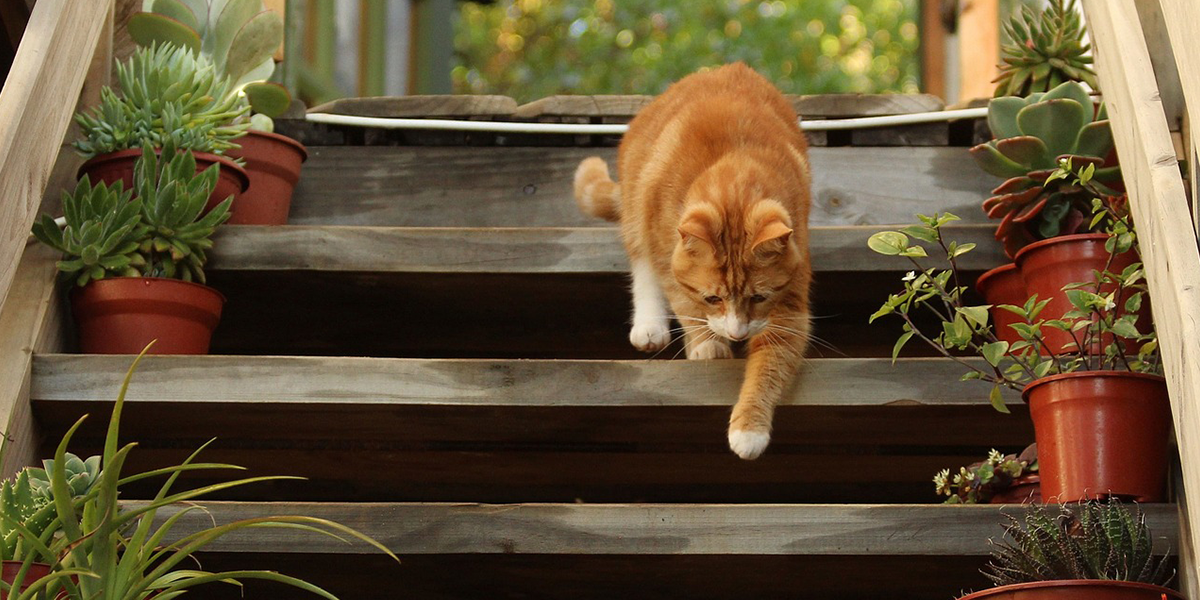The risks of letting your cat go outdoors
Letting a cat control its own movements in and out gives it freedom, but lays it open to the dangers of the great outdoors.
The main risks are:
- Injury – Road traffic accidents account for many cats’ lives every year. If you live in a town or near a busy road then the risks are probably greater. Dogs, other cats and humans are also the cause of cat injuries.
- Poisoning – Cats can become poisoned by chemicals used in the garden or by eating poisoned prey.
- Disease – Contact with other cats (especially fighting) and the environment can lead to infections with, for example, feline immunodeficiency virus, feline leukaemia virus, cat flu or enteritis viruses.
- Infestation – Fleas and other parasites can be picked up from prey and the environment.
- Loss – Cats can sometimes get shut in garages or are driven away in cars or vans they have climbed into. They may even move in with someone else.
- Stress – A timid cat may find the great outdoors very stressful and prefer to be inside.
The benefits
However, there are also many benefits to letting your cat go out:
- Rodent control – Cats help to keep the rodent population around your home at bay.
- Social contact – Outdoor cats can have social stimulation if they want to interact with other cats in the area.
- Regular exercise – Outdoor cats are well exercised through hunting and generally being out and about, and are less likely to become overweight.
- Outlet for behavioural needs – less stress for the cat and therefore improved welfare.
- Good behaviour – Outdoor cats are less likely to develop behavioural problems such as inappropriate urination in the house, clawing furniture or stalking humans or other household companions. They are less likely to become bored or frustrated.
Minimising the risks
Before deciding that the myriad risks of a free-roaming outdoor cat are too great, consider ways in which you can minimise them.
- Let your cat out in the day but shut him in at night as this is a more dangerous time to be out. There are more wild animals around and cats can be dazzled by car headlights on the road. A reflective or fluorescent collar may help get him seen, particularly in the winter months when it gets dark earlier. If you can train your cat to come when he is called you will be able to let him out at dawn and make sure he is in by dusk each day.
- If you are near a busy road try to encourage your cat to come in (by feeding at this time) at busy times in the morning and evening.
- Ensure that your cat is vaccinated against all infectious diseases it is possible to cover (as yet there is no vaccine for FIV). Worm your cat regularly, especially if he is a hunter.
- If your cat is wearing a collar make sure it is one with a safety catch which will enable him to escape should the collar get caught up in a tree or fence. Write your name and phone number on it clearly so that anyone finding him sick or injured can let you know. Many people now have their cats microchipped (click here for information on identifying your cat and on microchips). A microchip the size of a grain of rice is injected under the skin that carries a unique number. Cats taken to rescue centres are automatically scanned for this and matched to the address on file.
- Make sure that your cat is neutered. The risks to entire animals are much greater than to neutered cats. An unneutered tom will wander for miles, often crossing busy roads. The average lifespan of an unneutered male is probably only a couple of years. Neutered animals do not wander so far, do not fight so much (and therefore are not at such a great risk of being infected with various diseases), and do not cause the noise and smell nuisance to neighbours that an unneutered torn can inflict. The risks of pregnancy to the unneutered female are also obvious.
- Consider creating a controlled outdoor territory to enable your cat to have access to your garden, without the risk of free-roaming farther afield. Depending on the configuration of your garden, you could consider a humane cat fencing solution such as a fence barrier or outdoor cat enclosure. For small suburban spaces, catios are a great option.
Thank you for visiting our website, we hope you have found our information useful.
All our advice is freely accessible to everyone, wherever you are in the world. However, as a charity, we need your support to enable us to keep delivering high quality and up to date information for everyone. Please consider making a contribution, big or small, to keep our content free, accurate and relevant.
Support International Cat Care from as little £3
Thank you.
Donate Now


